Key takeaways
- Critiquing music involves understanding the artist’s intention and embracing feedback as a tool for growth, rather than judgment.
- Performance analysis requires breaking down elements like tone, timing, and emotional expression, rather than focusing solely on technical skills.
- YouTube serves as a valuable resource for studying diverse performances and cultural styles, enhancing appreciation for different musical expressions.
- Developing a personal critique style involves trusting one’s instincts and adapting to the unique characteristics of each performance.
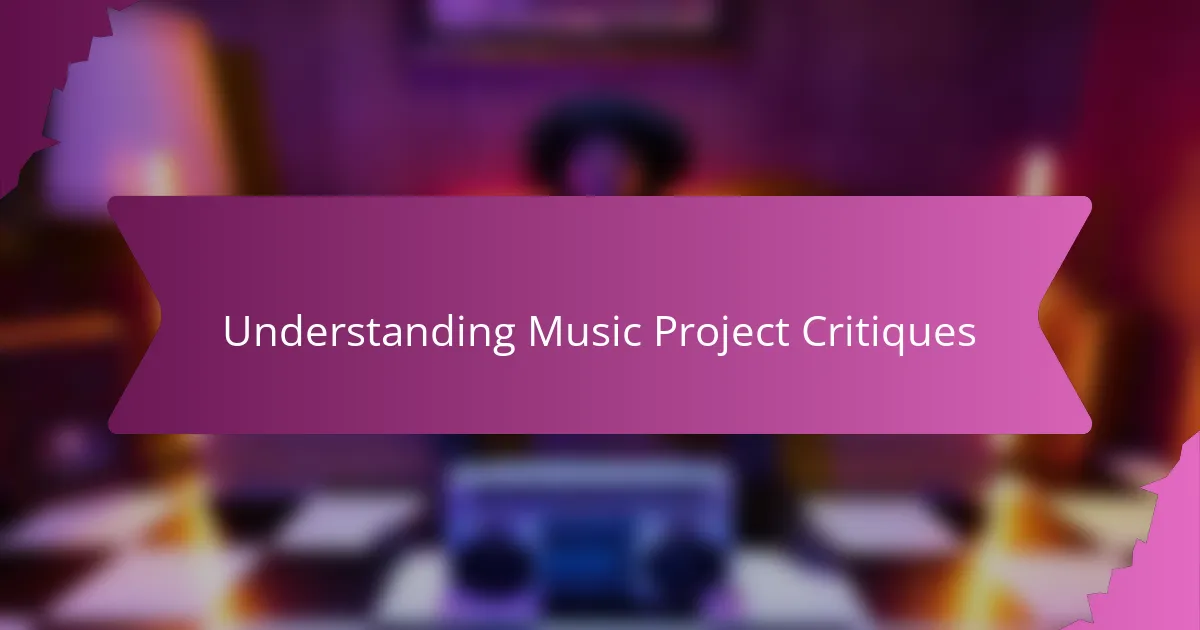
Understanding Music Project Critiques
When I first started critiquing music projects, I quickly realized it’s not just about pointing out flaws. It’s about understanding the artist’s intention and the story behind every note and lyric. Have you ever listened to a song differently after learning why it was made? That shift in perspective changed everything for me.
One thing that surprised me was how personal critiques can feel. It’s easy to take feedback as a judgment, but in reality, it’s all about growth—both for the creator and for me as a listener. When I approach a critique, I ask myself, “What message is this project trying to convey, and how well does it succeed?” This question keeps the process respectful and insightful.
Critiquing helped me develop a more nuanced ear. Instead of just reacting to what I like or don’t like, I learned to identify specific elements like arrangement, dynamics, and emotional delivery. It’s like learning a new language, one that lets me communicate with music on a deeper level. Have you felt that connection when a piece suddenly clicks after a thorough listen? That’s the power of understanding music project critiques.
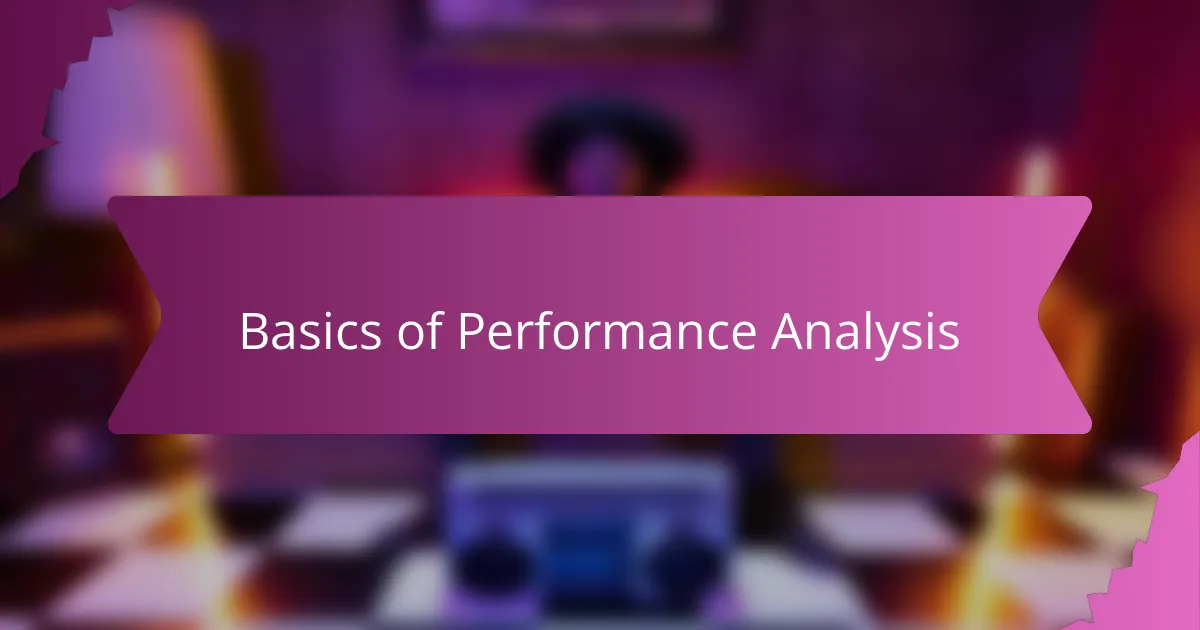
Basics of Performance Analysis
Performance analysis, at its core, means listening with intent. I found that breaking down a performance into smaller parts—tone, timing, and expression—helped me see the bigger picture without getting overwhelmed. Have you ever caught yourself zoning out during a piece and then suddenly noticing a subtle change that completely transformed how you feel about it? That’s the moment analysis starts to click.
I often focus first on the performer’s technical skills, like pitch accuracy and rhythm steadiness. Yet, I’ve learned it’s just as important to tune into the emotional energy they bring—does their passion translate through their instrument or voice? Sometimes a technically imperfect but heartfelt performance stays with me far longer than a flawless yet cold rendition.
Another basic I keep coming back to is context. Knowing the genre conventions or the piece’s background colors what I listen for. For example, what might seem like an unusual choice in one style could be a deliberate creative twist in another. This awareness helps me resist quick judgments and appreciate the artist’s unique approach. Have you noticed how understanding context can totally reshape your listening experience? It sure did for me.
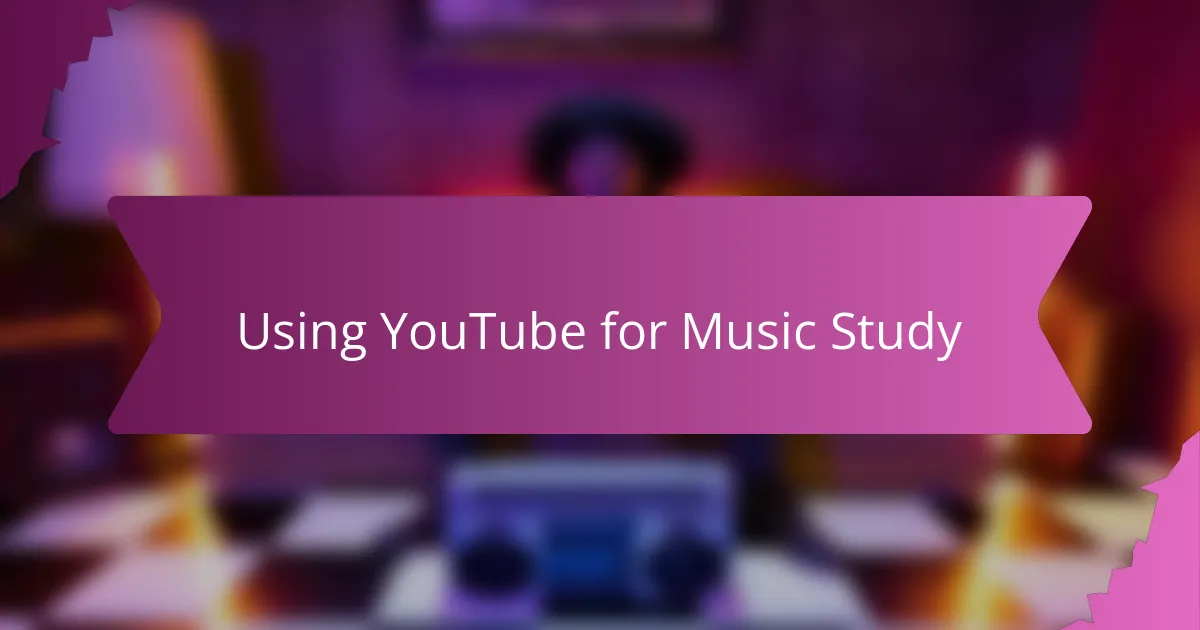
Using YouTube for Music Study
YouTube quickly became my go-to tool for deepening my music study. Watching countless performances side by side allowed me to spot subtle differences in phrasing and dynamics that I never noticed before. Have you ever found yourself rewinding just to catch a fleeting gesture or a shy smile from the performer? Those little moments taught me volumes about interpretation.
What surprised me most was the wealth of masterclasses and tutorials available for free. I remember stumbling upon a pianist’s breakdown of a challenging passage and feeling like I had a backstage pass to their thought process. Don’t you love when someone pulls back the curtain and reveals how they bring music to life? That insight made my critiques more informed and empathetic.
Another breakthrough came when I started engaging with different cultural styles on YouTube. Experiencing a flamenco guitarist’s raw passion versus a classical violinist’s refined polish expanded my understanding of performance norms. How often do we get to travel the globe through a single screen? This exposure taught me to appreciate diversity within music, making my critiques richer and more open-minded.
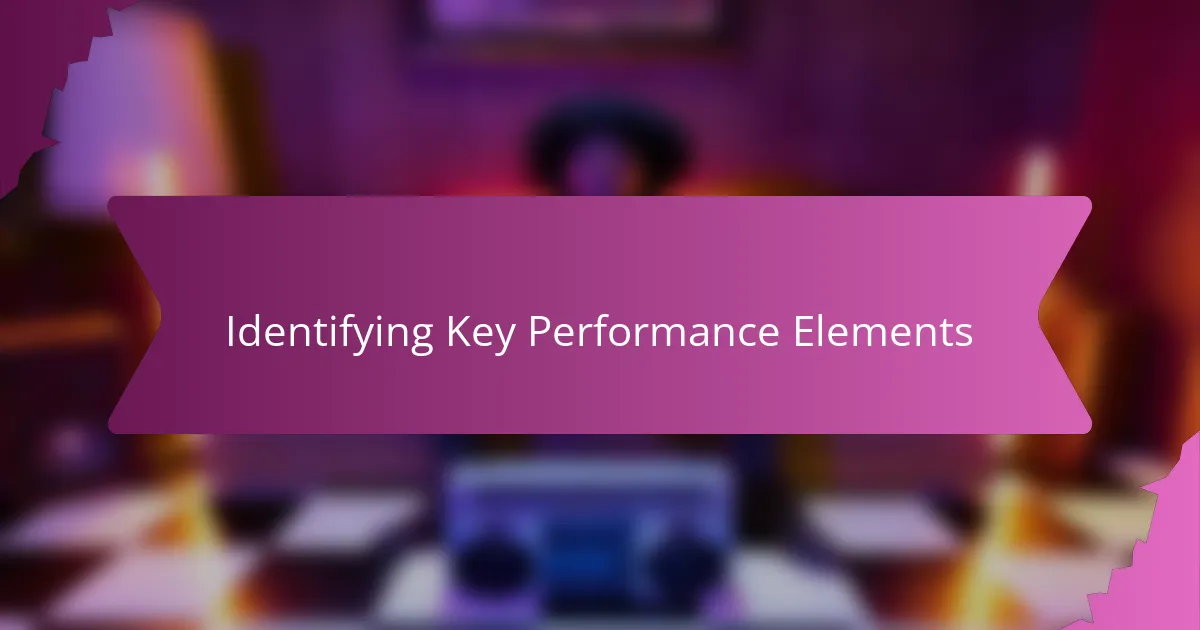
Identifying Key Performance Elements
One of the first things I learned was to pinpoint what truly defines a performance. Is it the artist’s phrasing, their stage presence, or maybe how they interact with other musicians? Sometimes a single element stands out and holds the whole piece together, like a vocalist’s subtle breath control that somehow makes every word feel intimate. Have you ever noticed how those small details can completely shape your experience of a live or recorded show?
I also discovered that not all key elements are equally obvious. While things like flawless timing catch immediate attention, it’s often the nuanced choices—like a guitarist’s slight hesitation before a solo—that reveal the performer’s emotional blueprint. Over time, I started asking myself: which moments feel rehearsed, and which feel alive and spontaneous? This helped me understand the difference between technical skill and genuine expression.
Identifying these elements became a kind of treasure hunt during my YouTube sessions. Watching the same song performed by different artists, I’d focus on what changes and what stays consistent. Did the pianist increase the tempo here? Was the singer’s vibrato more pronounced? Those comparisons sharpened my ear and deepened my appreciation—not just for the music, but for every tiny artistic decision that shapes a performance. Have you ever caught yourself replaying a clip to catch something you missed the first time? That’s the magic of digging into key performance elements.
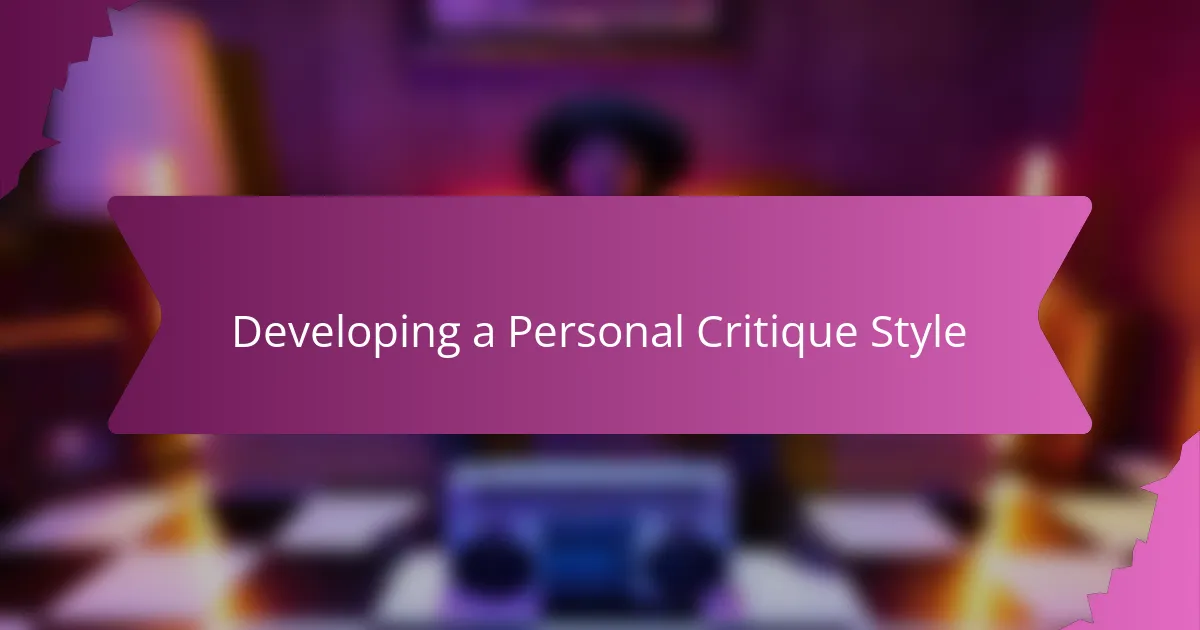
Developing a Personal Critique Style
Finding my own voice in critiquing performances was a gradual journey that felt as personal as the music itself. I realized that developing a personal critique style meant trusting my instincts while also being open to learning. Have you ever hesitated, wondering if your opinion “counts” or if you’re reading too much into a performance? That uncertainty faded once I saw critique as a dialogue, not a verdict.
I started framing my critiques around what resonated with me emotionally and intellectually. Instead of ticking technical boxes alone, I asked myself how the performance made me feel and why. This approach brought depth to my feedback and made each critique uniquely mine, reflecting my tastes and values as much as the artist’s work.
Over time, I embraced the idea that no single style fits every performance or artist. Sometimes, I’m detailed and analytical; other times, I trust a gut reaction or a vivid image that sticks with me. This flexibility keeps my critiques fresh and authentic. Have you found that letting go of rigid rules can actually sharpen your listening? For me, it was a game changer.
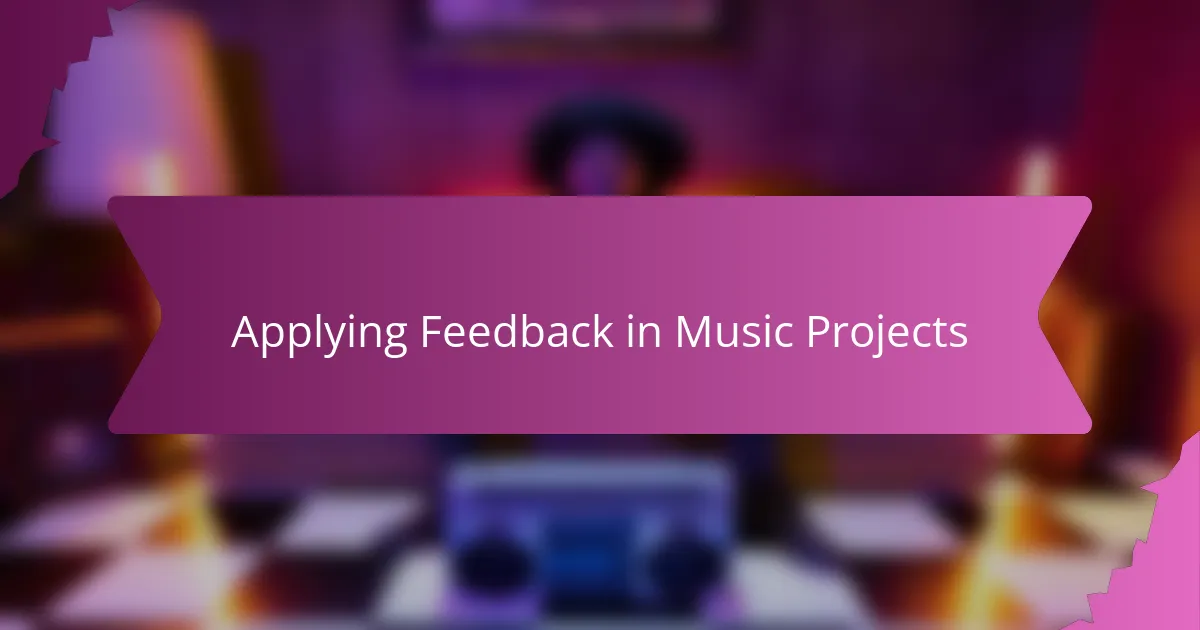
Applying Feedback in Music Projects
Applying feedback in music projects is where critique truly comes alive for me. It’s one thing to identify what could be better, but it’s another to take those insights and let them shape the next step in the creative process. Have you ever noticed how a single piece of advice can totally shift your approach—maybe changing a vocal phrasing or tweaking a rhythm—and suddenly the whole project feels more genuine?
I remember a time when feedback pointed out that my guitar track sounded technically solid but lacked emotional punch. That stung at first, but it pushed me to experiment with softer dynamics and more expressive bends. The result? A performance that connected not just with me but with others, too. Isn’t that the real goal—making music that moves both the creator and the listener?
What’s crucial is embracing feedback not as criticism but as a tool for growth. When you actively apply what you learn from critiques, each project becomes a stepping stone, richer and more refined than the last. How often do you revisit earlier work after gaining new perspective and notice improvements you couldn’t have imagined before? For me, that’s the magic of evolving through feedback.
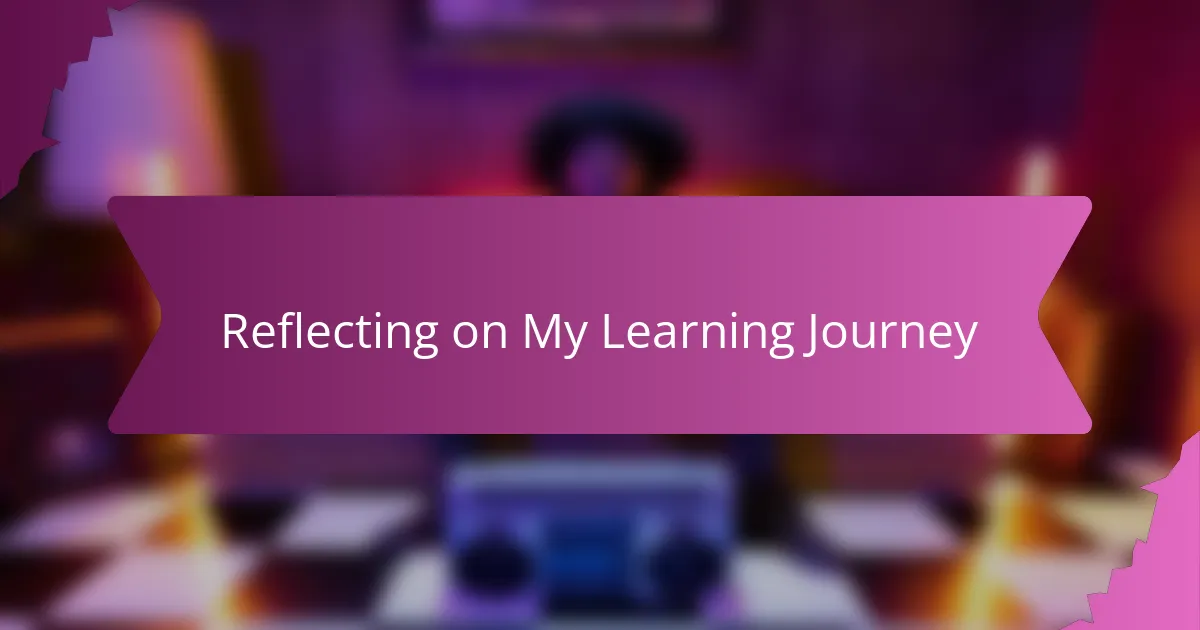
Reflecting on My Learning Journey
Looking back on this learning journey, I realize how much patience and curiosity it required. At first, critiquing felt intimidating—like I was stepping into a huge, complex world with no map. Have you ever felt that hesitation when starting something new? It’s that mix of excitement and doubt that pushed me to keep exploring performances on YouTube with a more attentive ear.
I also noticed how my perspective shifted over time. What once seemed like mere nitpicking turned into genuine appreciation for the layers and intentions behind each performance. Sometimes, I’d catch myself smiling at a small detail others might miss—a fleeting glance from a performer or a subtle dynamic change. Don’t you think those moments make listening feel alive and personal?
Reflecting now, I see that this process has shaped not only how I listen but how I connect with music emotionally. It’s not just about spotting technical things anymore; it’s about feeling the story and passion that come through every note. That emotional engagement, for me, is the heart of meaningful critique—and it’s what makes this journey so rewarding.